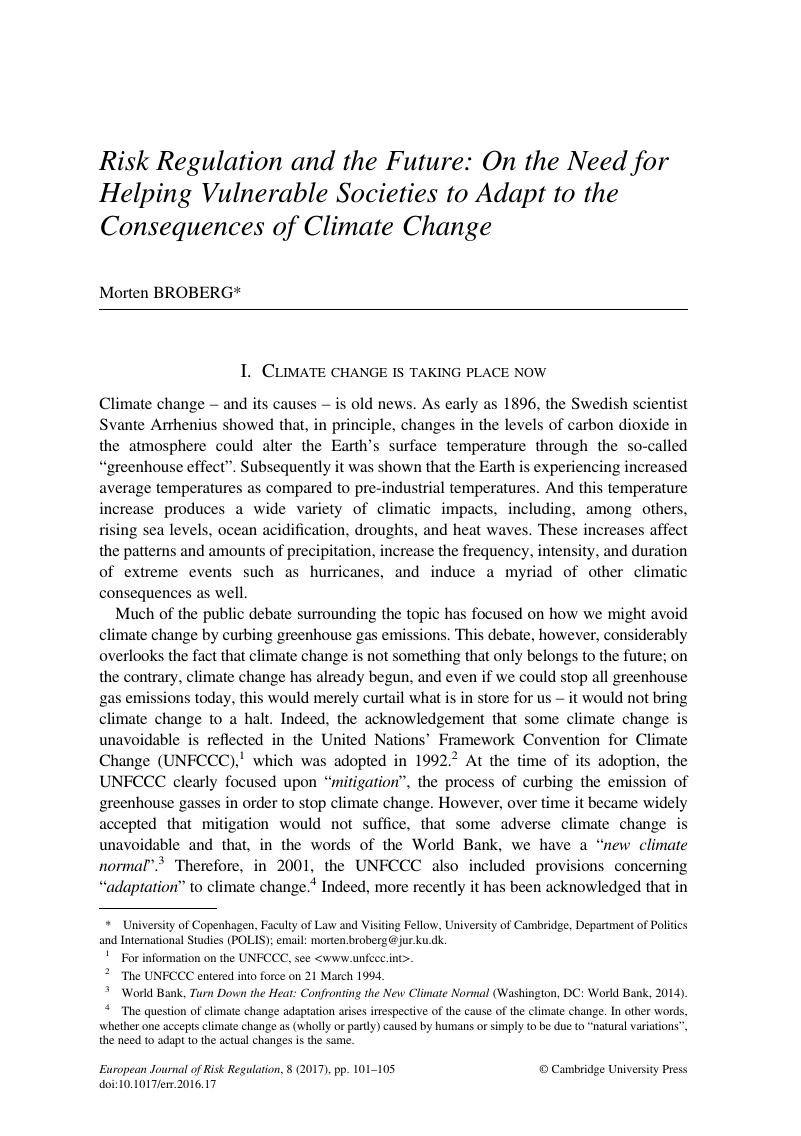Published online by Cambridge University Press: 26 April 2017

University of Copenhagen, Faculty of Law and Visiting Fellow, University of Cambridge, Department of Politics and International Studies (POLIS); email: [email protected].
1 For information on the UNFCCC, see <www.unfccc.int>.
2 The UNFCCC entered into force on 21 March 1994.
3 World Bank, Turn Down the Heat: Confronting the New Climate Normal (Washington, DC: World Bank, 2014).
4 The question of climate change adaptation arises irrespective of the cause of the climate change. In other words, whether one accepts climate change as (wholly or partly) caused by humans or simply to be due to “natural variations”, the need to adapt to the actual changes is the same.
5 “Mitigation”, “adaptation” and “remediation” are sometimes referred to as the “three pillars” of the UNFCCC.
6 For example, The World Bank’s first Turn Down the Heat report from 2012 (which offered a global overview of climate change and its impacts in a world that is 4°C warmer) concluded that impacts are expected to be felt disproportionately in developing countries around the equatorial regions, cf. World Bank, Turn Down the Heat: Why a 4°C Warmer World Must be Avoided (Washington DC: World Bank 2012).
7 Where we are unable to establish the “probability” we may have to, instead, think more in terms of “uncertainty”.
8 J Lelieveld, Y Proestos, P Hadjinicolaou et al., “Strongly increasing heat extremes in the Middle East and North Africa (MENA) in the 21st century” (2016) Climatic Change 137, 245. doi:10.1007/s10584-016-1665-6.
9 Today, in the field of climate change, the term “multiplier effect” is frequently used to denote a situation where a small climatic impact can produce big changes to the society as such. However, traditionally the term “leverage point” has been used with the same meaning.
10 The term “synergistic effect” has been borrowed from the sciences. See, for example, A Hougaard Laustsen, “Toxin synergism in snake venoms” (2016) Toxin Reviews, DOI: 10.1080/15569543.2016.1220397.
11 What is suggested here essentially is the development of complexity theory to allow us to understand how different climate change impacts may affect societies – broadly speaking.
12 As observed in note 7 above, in these situations, it might be useful to think more in terms of “uncertainty” than in terms of “probability”.
13 E Held, Biotech Benefits: Drought- and Salinity-Resistant Crops (Food Insight 2016) available at <http://www.foodinsight.org/blogs/biotech-benefits-drought-salinity-resistant-crops-global-warming>.
14 Similarly, it seems that the most climate change resilient societies are those that have a high level of good governance. Thus, if for example a development aid donor wants to help a developing country build climate change resilience, it may well be that part of the aid should be targeted on assisting the country in establishing good governance systems.